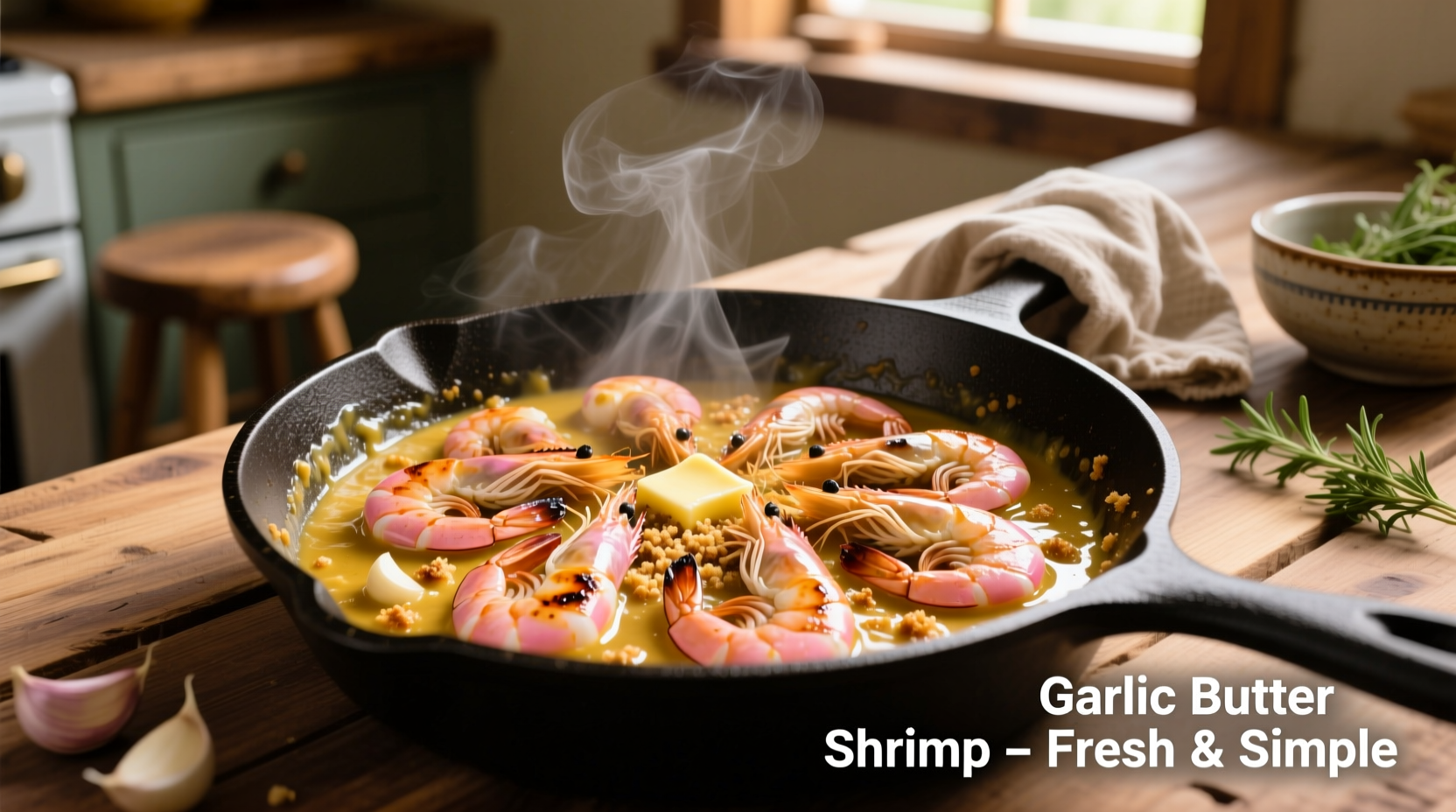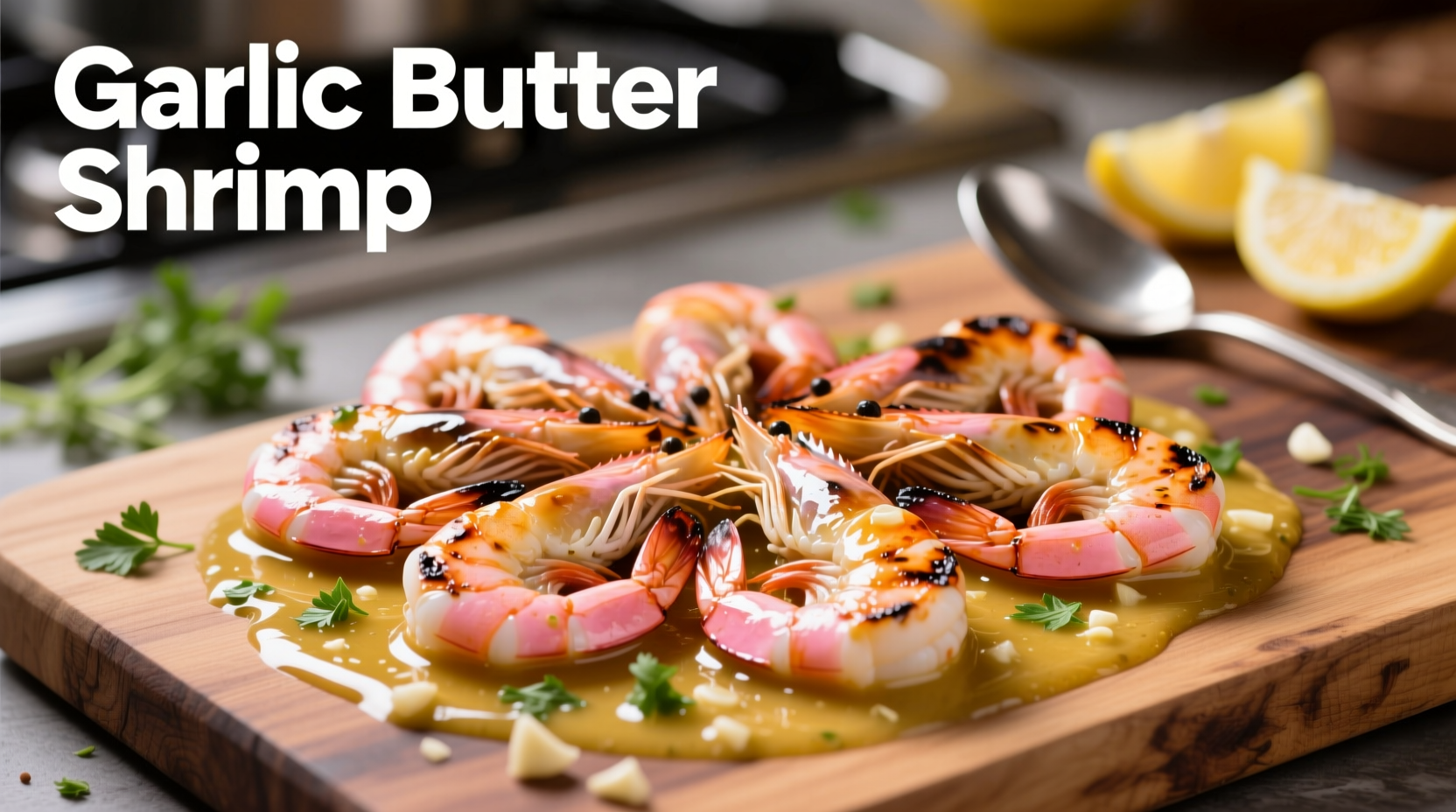The perfect garlic butter for shrimp combines 8 tablespoons of unsalted butter, 6 minced garlic cloves, 2 tablespoons fresh lemon juice, 1 tablespoon chopped parsley, and a pinch of red pepper flakes. This classic ratio creates a rich, aromatic sauce that enhances shrimp without overpowering its delicate flavor, ready in just 10 minutes with proper technique.
Why This Garlic Butter Recipe Works Every Time
Creating exceptional garlic butter for shrimp isn't just about mixing ingredients—it's understanding the chemistry behind flavor extraction. Professional chefs consistently use an 8:6 butter-to-garlic ratio because butter's fat content effectively carries garlic's volatile compounds while preventing burning. According to the US Food Safety and Inspection Service, proper butter temperature control (between 140-160°F) ensures optimal flavor release without compromising food safety when preparing seafood dishes.

Your Essential Garlic Butter Toolkit
Before you begin, gather these kitchen essentials that make the difference between good and restaurant-quality results:
- Unsalted butter (8 tablespoons) - Allows precise salt control
- Fresh garlic (6 cloves, finely minced) - Never use pre-minced for optimal flavor
- Lemon juice (2 tablespoons, freshly squeezed) - Balances richness
- Fresh parsley (1 tablespoon, chopped) - Adds brightness
- Red pepper flakes (¼ teaspoon) - For subtle heat
- Salt (to taste) - Enhances all flavors
| Butter Type | Garlic Ratio | Best For | Flavor Duration |
|---|---|---|---|
| Unsalted butter | 8:6 | Shrimp sautéing | 2-3 minutes |
| Ghee | 8:8 | Grilled shrimp | 4-5 minutes |
| Compound butter | 8:4 | Baked shrimp | 8-10 minutes |
The Step-by-Step Method Professional Chefs Use
Follow this precise sequence to extract maximum flavor while preventing common mistakes:
- Prepare your garlic - Mince cloves finely but don't use a garlic press (creates bitter compounds)
- Warm your pan - Medium-low heat only (garlic burns above 325°F)
- Melt butter gradually - Add 2 tablespoons at a time, swirling constantly
- Add garlic after butter foams - Cook 60-90 seconds until fragrant but not browned
- Incorporate acid - Stir in lemon juice to stop cooking process and preserve freshness
- Finish with herbs - Remove from heat before adding parsley to maintain vibrant color
Applying Garlic Butter to Shrimp Perfectly
The timing of garlic butter application determines your final dish's success. Food science research from the USDA National Institute of Food and Agriculture shows that shrimp proteins begin to toughen after 2 minutes in butter above 160°F. Follow this sequence:
- Cook shrimp first until 70% done (about 1½ minutes per side)
- Remove shrimp temporarily while finishing sauce
- Return shrimp to sauce for final 30 seconds to coat evenly
- Serve immediately—garlic butter separates after 5 minutes off heat
When Garlic Butter Works Best (And When to Avoid It)
Understanding context boundaries prevents culinary disappointment. This sauce excels with:
- Medium-sized shrimp (31/40 count) - Larger shrimp overwhelm delicate garlic notes
- Fresh or properly thawed frozen shrimp - Never use with previously cooked shrimp
- Simple preparation methods - Sautéing, broiling, or grilling
Avoid using this garlic butter with:
- Pre-cooked shrimp (becomes rubbery)
- Strongly flavored preparations like Cajun or curry
- Extended cooking times beyond 3 minutes
Evolution of Garlic Butter in Seafood Cooking
Garlic butter's journey with seafood reveals why this combination endures:
- 1920s - French chefs first documented butter-garlic preparations for fish
- 1950s - Emerged in American seafood restaurants as "steakhouse style"
- 1980s - Became mainstream with the rise of quick-service seafood chains
- 2000s - Food science revealed optimal garlic-to-butter ratios for flavor extraction
- Today - Considered a fundamental technique in culinary schools worldwide
Three Professional Variations Worth Trying
Once you've mastered the classic version, these chef-approved variations add sophistication:
- Lemon-herb version - Add 1 teaspoon lemon zest and ½ teaspoon thyme with the parsley
- White wine reduction - Deglaze pan with ¼ cup dry white wine before adding butter
- Roasted garlic option - Substitute 3 raw cloves with 6 roasted garlic cloves for deeper flavor
Troubleshooting Common Garlic Butter Problems
Fix these frequent issues with professional solutions:
- Burnt garlic - Start with cold butter in cold pan, cook slowly
- Separated sauce - Whisk in 1 teaspoon cold water to re-emulsify
- Too strong garlic flavor - Blanch minced garlic in boiling water for 30 seconds first
- Lack of depth - Add ½ teaspoon Dijon mustard for complexity without noticeable flavor
Storing and Reusing Leftover Garlic Butter
Maximize your efforts with proper storage techniques. According to food preservation guidelines from the USDA Agricultural Research Service, garlic butter maintains optimal flavor for:
- Refrigeration: Up to 5 days in airtight container
- Freezing: 3 months when portioned in ice cube trays
- Never store at room temperature more than 2 hours
Frequently Asked Questions
Can I use garlic powder instead of fresh garlic in garlic butter for shrimp?
No, garlic powder creates a completely different flavor profile that doesn't work well with shrimp. Fresh garlic contains allicin compounds that provide the characteristic aroma and flavor that powder cannot replicate. If you must substitute, use 1 teaspoon garlic powder per 3 fresh cloves, but expect significantly less complex flavor and potential bitterness.
How do I prevent garlic from burning when making garlic butter?
Add garlic to melted butter at medium-low heat (no higher than 325°F), stirring constantly for 60-90 seconds until fragrant but not browned. Professional chefs often add a tablespoon of water to the pan first, which creates steam that regulates temperature. Never add garlic to hot, dry pans as this guarantees burning.
What's the best way to incorporate garlic butter with already cooked shrimp?
For pre-cooked shrimp, warm them gently in the garlic butter for no more than 30 seconds. Overheating causes shrimp to become rubbery. Better yet, serve the garlic butter on the side as a dipping sauce to maintain shrimp texture while providing flavor. This approach preserves both the delicate shrimp texture and fresh garlic flavor.
Can I make garlic butter for shrimp ahead of time?
Yes, but with limitations. Prepare the garlic butter up to 24 hours ahead and refrigerate. When ready to use, gently reheat in a saucepan over low heat, adding 1-2 teaspoons of water to restore emulsion. Never make it more than a day ahead as garlic flavor intensifies and can become overpowering. For best results, prepare just before cooking.
Why does my garlic butter separate when I add it to shrimp?
Garlic butter separates when temperature changes too rapidly or when shrimp releases moisture. To prevent this, ensure your shrimp is patted completely dry before adding to the sauce, and remove the pan from heat before incorporating the butter. Whisk constantly while adding small amounts of butter to the pan. If separation occurs, remove from heat and whisk in 1 teaspoon of cold water to re-emulsify.











 浙公网安备
33010002000092号
浙公网安备
33010002000092号 浙B2-20120091-4
浙B2-20120091-4